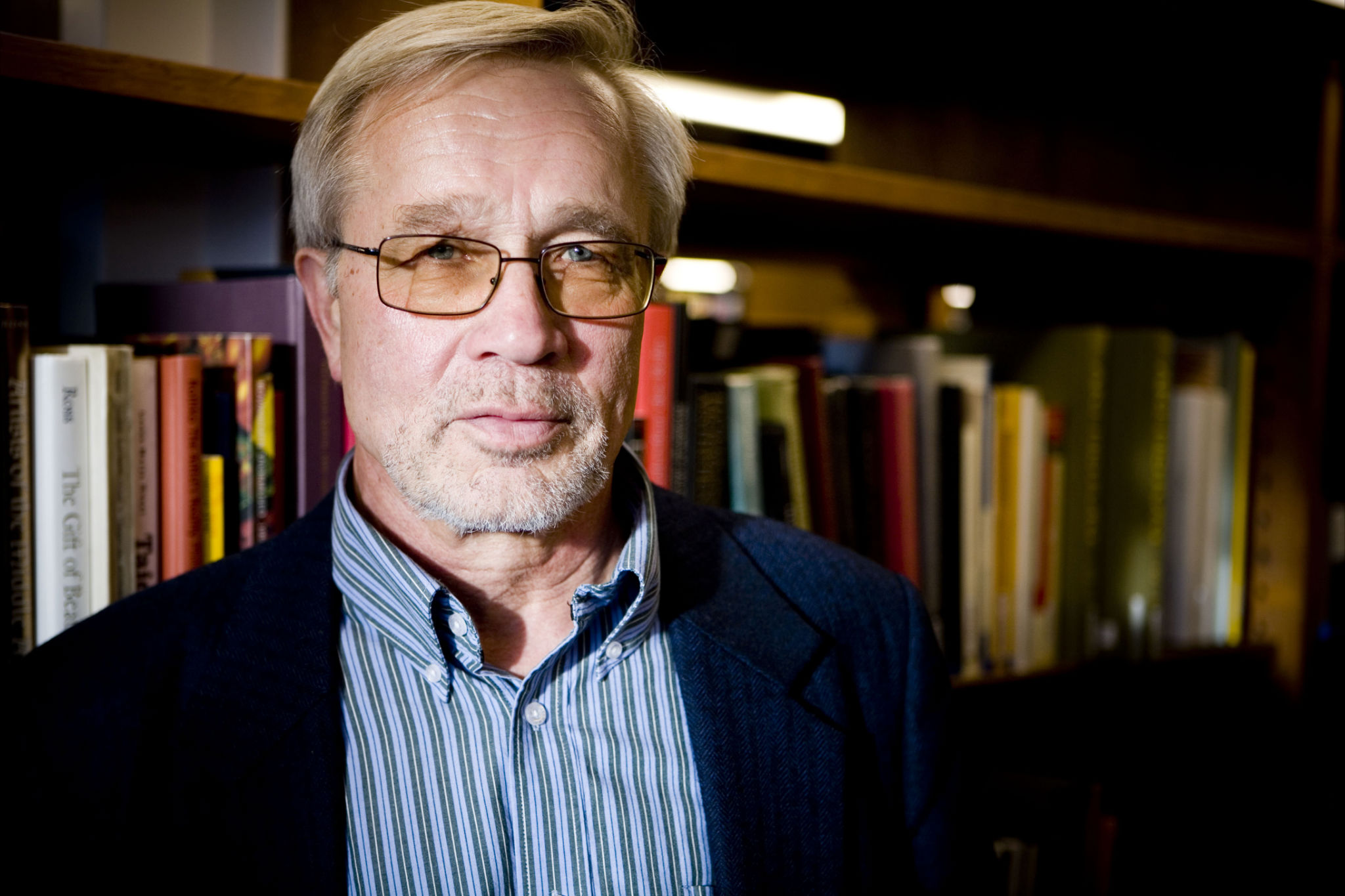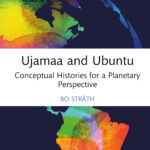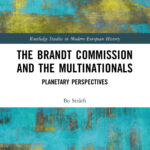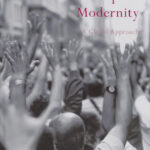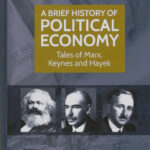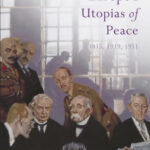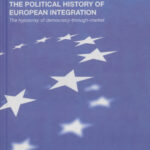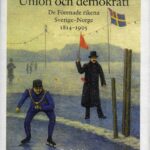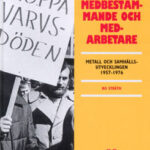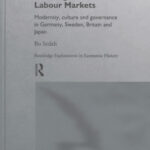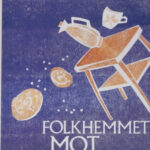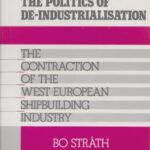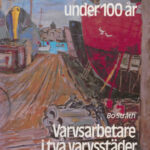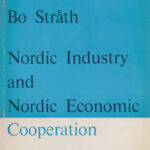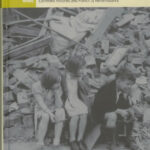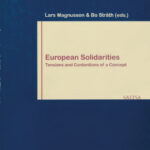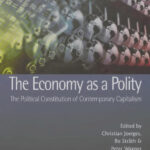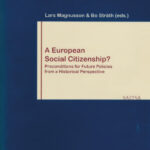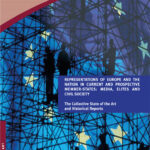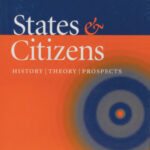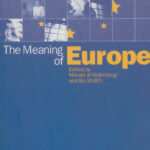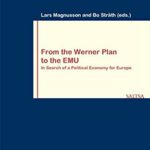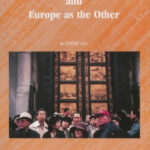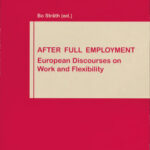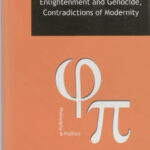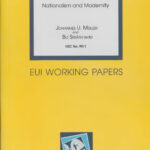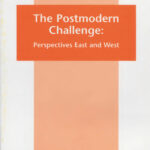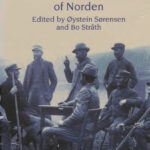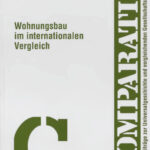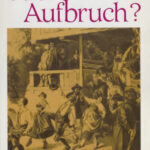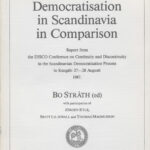Transatlantic relations: a brief history since 1945
In 1945, the US emerged as the world’s leading power. Unlike after World War I, the president and Congress now concluded that the country was a world power and acted accordingly. Very soon, the Soviet Union emerged as a challenger to that position, and the US took up the gauntlet. In a situation where the European empires had destroyed themselves, the two remaining empires divided Europe between them. The Marshall Plan of 1947 opened a new phase in transatlantic relations, more intense than before and with much clearer American leadership claims, all against the backdrop of the Cold War. The NATO military alliance, with West German participation from 1955, underscored the military emphasis in relations. The Korean War of 1950-53 reinforced them during the nuclear standoff of the 1950s.
However, after the related Congo, Berlin, and Cuban crises of 1960-62, which in retrospect appear to be the culmination of the nuclear threat, they were never consistently harmonious for any length of time. Charles de Gaulle openly distrusted the dollar as the world currency and the US as a world power. France left the military part of NATO. The abandonment of the dollar’s gold standard in 1971–73 further disrupted relations. The euphoria following the fall of the Soviet Union changed the conditions for transatlantic cooperation. The global perspective came to the fore. This did not change in principle when 9/11 in 2001 put an end to the dream of the end of history and a single liberal world as envisioned by Francis Fukuyama (1992). Samuel Huntington (1996) had already rejected Fukuyama’s worldview a few years earlier, when he described the future as a clash of civilizations. The attack on the Twin Towers seemed to confirm Huntington’s thesis and led to a moralistic neo-conservative wave with a struggle for democracy and Western values throughout the world. The Iraq War in 2003 was the culmination of the campaign that drove a wedge into European cooperation. As is well known, it was a war justified by lies. Defense Secretary Donald Rumsfeld imperiously divided Europe into the old, which refused to participate in the war, and the new, which joined the hunt for Hussein in the “coalition of the willing.” Robert Kagan’s book Of Paradise and Power: America and Europe in the New World Order (2003), which spoke of the US as Mars and Europe as Venus, gave expression to strong transatlantic tensions that spread to within Europe. Formally, NATO was not involved. However, during this turbulent period of transatlantic tensions, there was a détente between Russia and West that seemed to merge into one. The new Russia was linked to NATO through the Partnership for Peace in 1994 and the NATO-Russia Council in 2002. During the period of mutual understanding in relations with Russia, NATO increasingly became an international force for robust police/military intervention in local conflicts globally and less and less an invasion defense force. Within the framework of mutual understanding, Poland, the Czech Republic, and Hungary became NATO members in 1999. The Baltic states, Romania, Bulgaria, Slovakia, and Slovenia followed in 2004, the same year that most Eastern European countries became members of the EU. The spirit of consensus held for this NATO expansion, but it was short-lived. Russia had a complicated relationship with Georgia ever since the collapse of the Soviet Empire. A strong movement in Georgia wanted to draw the country closer to the West, toward the EU and NATO. With the clearly Western-oriented President Saakashvili, this movement gained a face. The president’s increasingly vocal ambitions had a negative impact on relations between NATO and Russia, which deteriorated noticeably from 2006 onwards. In February 2007, Putin gave a widely noted speech at the annual security conference in Munich, in which he clearly distanced himself from the new world order, which he described as monopolistic. It was clear who he was accusing of monopolistic ambitions. In May 2007, the US began talks with the governments in Warsaw and Prague about placing missiles in Poland with associated radar facilities in the Czech Republic. Georgia’s plans to seek NATO membership led to the 2008 war in Georgia. The Euromaidan protests in Ukraine from November 2013 to February 2014 were a protest against the pro-Russian government’s decision not to sign an association agreement with the EU. The protests ended with the president’s flight and Russia’s response with military infiltration in Donbas and the annexation of Crimea.
The growing tensions between Russia and NATO over power in the Caucasus and Ukraine temporarily strengthened transatlantic relations after 2014. But with Donald Trump in the White House from 2017 to 2021, tensions grew again, especially over the financing of military cooperation, where the US was initially the clearest financial backer. Russia’s attack on Ukraine in February 2022 reinforced the spirit of cooperation, but with Trump’s return to power in January 2025, the Atlantic divide became deeper than ever, while Trump moved closer to Russia.
The post-1945 Western order centered on the US is dead. Since 1949, the cornerstone of that order has been NATO, which is more central than the Bretton Woods institutions, the IMF and the World Bank. The essence of NATO is Article 5 on mutual assistance. In an emergency, this article cannot be tested legally but is moral and based on mutual trust. Trump has undermined that trust by making the article a question of whether the Trump regime considers that European members have paid enough for their self-defense. It has been clear since 2014, and since February 2022 emphatically underlined, that NATO’s threat is Russia. This is said without going into the hotly debated question of whether NATO, from Russia’s perspective after 1990, was a threat to Russia, but with the observation that the debate in any case does not provide a basis for Russia’s attack on Ukraine. After the full-scale war of aggression in February 2022, NATO was increasingly reactivated in strategic thinking and planning as the invasion defense it was from the beginning. Trump’s rapprochement with Russia behind Europe’s back has, even more than the financial controversy over the size of defense spending, emphasized the disintegration of what was called the West. NATO continues formally, but Europe does not share the US threat assessment.
The situation in spring 2025
Since Trump’s second inauguration, a profusion of commentary has commented on the disintegration of the world order and sought explanations in and beyond Trump himself, in both the long and short term. The aim here is not to summarize the debate, but to identify some lines of argument as a basis for a discussion of what is happening and why. It is a historical irony that the community around the concept of the West, created by an American president almost 80 years ago, is now being torn apart by another American president. A transatlantic world order that is almost eighty years old – no longer, but no shorter either – a history from Truman to Trump is being destroyed, deliberately, momentarily and with a sledgehammer. By ruling with presidential decrees and public statements, often short and drastic on social media, Trump is shaping public opinion and creating facts that bypass Congress and provocatively defy court decisions. Politics is accelerating and simplifying complex contexts. It arouses strong emotions and becomes polemical. It is about regaining lost American greatness (MAGA, Make America Great Again). China and Europe/the EU are portrayed as the main causes. While China is treated with a certain rhetorical respect, criticism of Europe is more unrestrained. The opening salvo from Vice President J D Vance at the annual security conference in Munich on February 14, 2025 (White House, 2025-02-14) caused astonishment, shock, and anger in Europe. In a confrontational style, Vance claimed that Europe is not sufficiently democratic. Two things in particular distinguish Europe from the US as a role model, and he demanded improvement in these areas. Europe treats right-wing populist parties badly. They must be clearly and unambiguously brought into parliamentary politics. The second point concerned restrictions on the freedom of digital platforms. These restrictions are an expression of undemocratic shortcomings in freedom of expression that must be corrected. Trump’s repeated territorial claims on Greenland, Canada, and the Panama Canal, with threats of annexation, were an open challenge to international law that reinforced the impression of a desired break with the world order that has been in place since 1945. In two cases, the claims were directed against countries that have been members of NATO since its inception in 1949.
In a speech on April 7, 2025, Trump’s economic adviser Stephen Miran clarified what the fight for MAGA is all about. The US provides two global public goods: a security umbrella monitored by the US military and the dollar, with US government bonds at its core, around which the international financial system revolves. Both are costly for the US, and the president wanted to make it clear that the US is no longer prepared to pay for other nations’ free ride (White House statement, April 7, 2025). The security policy aspect was expressed in the claim that European members of NATO are not paying their fair share of defense costs, which Trump claims is five percent of GDP. He sometimes expresses himself as if this refers to NATO members’ contributions to the NATO budget, whereas the figure actually refers to their defense spending as a share of their GNPs, where the consensus has been two percent. He made it clear that members who do not pay enough cannot expect active US support in the event of a war. With his ostentatious rapprochement with Russia under the guise of self-appointed mediator (in the Ukraine war), Trump has undermined trust in the alliance even more than with the doubts he has sown about Article 5. Trump has caused the entire alliance to falter. The security policy divide is compounded by the trade policy divide that Trump is creating through grotesque tariffs. The rules no longer apply. Rule-based international politics based on international law and trade law is giving way to the arbitrariness of power politics. The new tariffs are a demonstrative break with the neoliberal world order built up since the 1980s around ideas of free world trade with production where it is cheapest in global supply chains, where time precision replaces expensive warehousing and where wages and social standards are pushed down.
Protectionism is returning as a program for the first time since the 1930s, and the Trump administration’s arguments are reminiscent of mercantilism. In his speech on April 7, President Trump’s advisor Miran was clear about what the tariffs are about: forcing other countries to pay tribute to maintain the American empire. The financial commitments force the US to tax hard-working Americans unfairly, a statement that suggests a view that revenue from tariffs creates scope for tax cuts. But the idea is also to force industrial companies to move manufacturing to the US. The dollar as the world’s currency standard has led to distortions in exchange rates, which in turn have created unfair trade barriers and, in the long run, unsustainable trade surpluses against the US. The argument applies to trade in goods, while the large US trade surpluses in trade in services created by the digital tech giants are ignored.
Both problem areas, security and trade policy, are polarized by an unabashed image of Europe painted by the Trump regime, in which Europeans are freeloaders and parasites on the US. They are free riders. China is subjected to the same caricature, but emotions seem stronger when it comes to Europe. European integration, which culminated in the EU, was created to harm the US. The president offers no evidence to support this thesis. In NATO, Europeans do not pull their weight financially, and in trade they exploit the US unfairly. Europe appears not only as a caricature but also as an open enemy.
The conclusion is clear: the West as it emerged after 1945 no longer exists. The Trump regime is developing an enemy image in which the cause of all evil lies in Europe. In an essay, Fintan O’Toole develops his thoughts on Trump’s Europhobia (O’Toole 2025). Although Trump’s perception of reality is unstable and constantly changing, he has fixed ideas and unchanging instincts. It is these obsessions and instincts that are now reshaping relations between the US and Europe more dramatically than at any time since 1945. Trump is not walking away from Europe, he is trampling on it. His regime has not lost interest in Europe. It has developed a malicious interest in destroying the EU, writes O’Toole. Trump’s hostility toward the EU first manifested itself in his enthusiastic support for Brexit. During his first presidency, his conviction that the EU is an “enemy” on par with China bubbled up from time to time, but for the most part, the idea remained latent. Now, the interest is not in leaving Europe to its fate, but in undermining and reshaping the EU from within through open support for right-wing populist and extremist parties, as expressed by Musk, Vance, Rubio, and others. It is not just that the EU can no longer assume that the US is benevolent, but that it must assume that active ill will may develop in concert or cooperation with Russia.
The big problem is that the Trump regime is not only intervening in specific policy areas but is attacking the very system of norms surrounding concepts such as territorial integrity and national sovereignty. Trump is following Putin. This has tangible consequences, especially in international relations, where there is no Leviathan, no protective power that defends norms and rules through police and military force. Trump attacks the norm of freedom of research and issues detailed instructions to universities under threat. He shows contempt for scientific knowledge.
The language that began with fake news and false truth or alternative truth during the first term is accelerating in its departure from what used to be called the basis of reason. The scientific search for objective knowledge—combined with the realization that the objective can be viewed from multiple perspectives and that ideological prejudices can cloud the search—is being undermined and witch hunts are being revived. Kant’s critical reason as an academic principle of action is being rejected. The intention is possibly to create a basis for replacing the philosopher’s ideas with AI produced by tech giants.
Language is radicalized not only in the Orwellian sense, where war is called peace and peace is called war, but also by becoming more polarized and emotionalized. Immigration is called invasion. Emigration becomes remigration and deportation. It should be noted that this linguistic development is the same in Europe, where the immigration issue on both sides of the Atlantic is becoming a catalyst, a proxy issue for a range of other social problems, which can be summarized briefly as two: socio-economic problems in the wake of neoliberalism’s ravages and its collapse in the speculative bubble of 2008, and climate change. Language is becoming more excessive. We lack a language that describes the new world as the difference it is in relation to the democracy that was the standard. Its concepts use the democratic standard, but they do not fit (Stråth & Trüper 2025). Europe clings to the ideals it believed in and continues to use the expressions that shaped those ideals instead of describing the change. Europe wants to believe that it is still in the heyday of democracy, when it was taken for granted forever. Europe sees itself as a contrast to the fanaticism and cult of leadership that rules the US, driven by powerful interests in alliance with algorithms. It is existential for Europe to see the risks to democracy that the digital revolution has brought with it in Europe as well, and to create a language that describes those risks. What kind of public sphere do social media constitute in comparison to the public spheres that sustained democracies in the 1950s and 1960s? The distinction between public and private, which Thomas Hobbes proposed to rulers almost 400 years ago as a means of ending decades of religious wars in Europe, is disintegrating as the private becomes public in social media. This voluntary renunciation of privacy changes the conditions for social criticism and government control. The emotions that are boiling and the simplifications that destroy complex values are infantilizing and brutalizing public debate. It is existential for Europe to take control of algorithms and regulate them to save democracy. Quickly.
Although the conflict between the US and Europe is the main problem, it is important to remember that Europe is dangerously close to the US in the development that is causing so much disruption, namely the emotionalization and infantilization of public debate. One should not overemphasize the differences between the US and Europe in terms of the intensity of social media. One could speak of a close European tipping point where everything is moving in the American direction. Europe would like to be, but is not a bastion of values. We should build on that insight.
A world order in dissolution. What now?
Signs of a different US emerged as early as the Iraq War, and a trend reversal occurred with the election of Trump as president in 2016, which European leaders did not want to see and instead hoped that his mandate would be temporary and that he would be open to dialogue during his term. In 2020, with the election of Biden, they saw Trump as a historical footnote. Today, we know that Biden was the parenthesis. In the European debate ahead of the presidential election in the fall of 2024, everyone professed to be preparing for Trump’s comeback, but the preparation was more about convincing themselves, without closer analysis, that Trump would be the same as last time and that the solution lay in finding a deal by flattering him. During the fall, preparations for Trump shifted more toward hopes for Harris. No one in the planning had imagined the Trump who came back, least of all his actions on the Ukraine issue. Everyone was caught off guard by his decisiveness, backed by the tech oligarchs, with or without chainsaws.
With intellectual authority, Jürgen Habermas described the rupture in strong terms in a newspaper article in March 2025 (Habermas 2025). He speaks of an epochal break that has profound consequences for Europe. If the EU fails to find a convincing response, Europe will be dragged into the vortex caused by the sinking superpower, he argues. For it is indeed a power in decline, not one on the rise. Habermas condemns the European leaders’ inability or lack of interest, their incomprehensible short-sightedness in their view of the US as a leading power. German Chancellor Scholz’s unwavering confidence in the unity of the West under Biden’s US in response to Russia’s war of aggression against Ukraine led the other European leaders in the wrong direction instead of pushing for Europe to take responsibility in Ukraine for defending its security and European values. This failure proved disastrous when Trump began negotiating with Putin over the heads of the EU, which was forced to watch from the sidelines, argues Habermas. With Trump 2, the question of Ukraine’s fate has become a question of the EU’s existential self-defense in a situation where it cannot count on the US for protection.
Scholz certainly bears some of the responsibility for Europe’s fixation on the US after Russia’s invasion of Ukraine, possibly more than anyone else. But in his defense, it can be said that Germany’s ties to the West had been firmly rooted since Adenauer and felt even stronger after the brutal end in February 2022 of the close relations with Russia under the motto Wandel durch Handel (change through trade). These were ties that Willy Brandt had forged in the early 1970s in a completely different historical situation under the motto Wandel durch Annäherung (change through rapprochement). When that motto was given its neoliberal formulation after 1990, the fateful idea arose that the market automatically drove the arrangement. As finance minister in the grand coalition with Angela Merkel, Scholz lost touch with Brandt’s ideas, but he was far from alone. In Germany, trust in the US was as unshaken as it was in Russia before February 2022, after people were able to dismiss Trump 1 with a sigh of relief as a parenthesis. Finally, the Finnish and Swedish NATO applications after the Russian attack on Ukraine show that Scholz’s Germany was not alone in its trust in the US.
If Scholz is now the most obvious candidate to be described as the Chamberlain of our time, the question is who is Churchill. Here, no one other than Ukrainian President Zelensky can be considered. Without going into the similarities in detail, one decisive difference can be identified. Churchill had the backing of the US and, after the summer of 1941, also the Soviet Union. The longer the war goes on, the more Zelensky seems to stand alone. The helplessness in Europe is growing as Trump and Putin negotiate over Ukraine. Europe faces the task of taking over the US role in supporting Ukraine, but there seems to be no place for Europe in the emerging dynamics. The difficulties are great, but the refusal to recognize this and draw the consequences makes them even greater.
The unpredictability is total against the backdrop of what Habermas describes as Trump’s “bizarre behavior and confused speech” at the inauguration ceremony in January 2025 with “the fantastic incantation of a now dawning golden age.” Trump’s narcissistic affectation gave the unprepared TV viewer who watched the ceremony the impression of a “clinical demonstration of a psychopathological case,” but the thunderous applause in the hall and “the expectant agreement of Musk and the other Silicon Valley luminaries” left no doubt about the determination of Trump’s inner circle. The roadmap bears the signature of the Heritage Foundation and has been known for a long time (Heritage Foundation 2024). It is about an institutional restructuring of the state. The European examples in the same vein, involving figures such as Orbán and the Kaczynski regime, are limited to state restrictions on the legal system and the media. The overhaul in the US is much more radical. Purge commissioner Musk, armed with a chainsaw, has more far-reaching goals than simply cutting back on government administration. The long-term goal is to replace the state apparatus and its regulations with a digitally controlled technocracy, argues Habermas. Politics within the framework of the historical state is to be replaced by digitally controlled corporate management by a severely slimmed-down state administration (Habermas 2025). The techno-oligarchs’ plans to transform the government into a corporate board would, if realized, have consequences that are difficult to foresee.
For Habermas, it is not entirely clear how these expansive ideas can be reconciled with Trump’s style of action, a “politics of surprisingly arbitrary decisions, freed from prevailing norms.” The dealmaker and real estate agent’s obscene fantasy of rebuilding the empty Gaza Strip suggests the irrationality of a deliberately unpredictable person who may clash with the vice president’s religiously driven long-term plans for a right-wing populist or autocratic definition of democracy, where complete digital freedom for tech giants is the guiding principle. Habermas notes that the authoritarian type of digitalization has little to do with historical fascism. Once destroyed, institutions cannot be easily recreated. To Habermas’ conclusion, one can add that the paladins, sycophants, and court jesters who make up the immediate entourage of the American president are by no means new. History provides many examples. What is new is their technological power, which raises questions about who really controls.
Unpredictability as a political instrument of power does not mean that Trump lacks a plan or a goal. One must assume that he is serious and has a plan to make America great and strong again, even if there is surprisingly little discussion of what such a plan might look like. It is difficult to discern any long-term thinking in a jerky approach where goals are specified and the call to attack is sounded just as quickly as the call to retreat: peace in Ukraine, tariffs to protect the US from foreign exploitation, etc. He calls for an attack and promises great things and breakthroughs, but when faced with strong resistance, the attack stops, and new energy is invested in a new goal, and so on. The shift from “peace mediation” in Ukraine to the unrestrained tariff campaign, and then back to Ukraine, follows a pattern.
Trump wants to destroy the institutions, rules, and patterns of cooperation of the existing world order. He wants to create a (dis)order where the strong rule. Small states do not matter. A handful of superpowers decide the fate of the world among themselves. Their agreements are often unwritten, secret, and/or implicit and not necessarily long-lasting.
It is a myth that imperialism disappeared with decolonization after 1945. During the Cold War, it continued in the Third World as proxy wars between superpowers and competition with conventional weapons (Westad 2005; Stråth & Trüper 2025). But, surprisingly, it has become as strong as it is today.
If you look at a globe from above and follow the Canadian landmass from the Labrador Channel westward, you come to Alaska and on across the Bering Strait to Siberia and finally to Murmansk. From there, it is a short step to Greenland. Looking in the other direction, eastward from Labrador, you quickly reach Greenland, and from there you can reach Murmansk from the other side. The US and Russia would embrace the globe under the North Pole if Greenland and Canada belonged to the US, and they would control both the Northwest and Northeast Passages. They would also check unknown quantities of rare minerals. It should be emphasized that this is hypothetical reasoning, and if it turns out to be true, it is one thing what Trump wants and another what he manages to achieve. But one must assume that Trump has a plan and a worldview. Putin’s Russia is unlikely to fall like ripe fruit for Trump’s invitations and also has a relationship with China to consider. The imperialist relations between the superpowers are not necessarily harmonious. They are power-driven and opportunistic, changeable rather than lasting friendships.
Against the backdrop of this hypothetical but not unrealistic thinking, it is striking how isolated and insignificant Europe appears in the game of peace in Ukraine and the rapprochement between the US and Russia. One can only conclude that if peace means that Putin gets to keep what Russia has conquered and Trump forces a torn and war-weary Ukraine to agree to American extraction of minerals in what remains of Ukraine, then yes, American digging and drilling will guarantee the integrity of the rest of Ukraine from Russian aggression. At what price, one might ask, but no European peacekeeping troops will be needed.
In a short article, Nils Gilman sees an oil and gas coalition against renewable energy emerging between the US and Russia on the basis of continued air pollution (Gilman 2025). In this context, it is worth noting the stated interest of both Russia and the US in the Middle East. Such a coalition controlling the Arctic with the Northwest and Northeast Passages would hardly be able to avoid a clash with China, which more than any other power has profiled itself as the champion of green energy. The US and Russia cannot count China out, and do not do so, but are seeking an arrangement with what was once called the Middle Kingdom and now seems to want to reclaim that name. A future triangle drama may be emerging instead of a triumvirate. Where does the EU stand in such a situation? India? Is the idea, if there is one, to appease Trump, or should the EU hope that everything will work out? Like the mouse that stares in shock at the snake, euphemistically attempting to hide its paralysis with the claim that it is keeping a cool head.
How could this happen? Two American interpretations
A flood of literature seeks to understand and interpret developments in the US. Two books will be highlighted here as a far from exhaustive illustration of the possible interpretations.
Robert Kagan, who likened the US to Mars and Europe to Venus (Kagan 2003), has abandoned his neoconservative convictions from the Iraq War era and reflects in a new book on how American developments could have turned out the way they did (Kagan 2024). His starting point is that the US Constitution of 1787 was flawed from the outset. It proclaimed the equality and rights of all people, but its authors were aware that black slaves were not included. Washington and Jefferson both owned slaves. The Founding Fathers consoled themselves with the hope that at some point in the development of the American people, reason would prevail and agreement would be reached on the abolition of slavery. In the 1830s, tensions arose when new states were to be admitted to the Union and their status on the slavery issue had to be determined. These tensions triggered the Civil War in 1861–65. The conflict was not only about slavery, but also about urban-rural divisions and different levels of industrialization, with illiberal forces continually challenging the liberal constitution.
After the civil war, immigration and industrialization intensified, and new tensions arose between new ethnic groups: Anglo-Saxons/Northern Europeans against Southern Europeans against Eastern Europeans against Chinese against Japanese. The Chinese Exclusion Act of 1882 and the Immigration Act of 1924 expressed these tensions. The melting pot was anything but harmonious. The race debate intensified. The 1920s were the era of jazz, but also of the Ku Klux Klan, and illiberal tendencies were evident during the crisis of the 1930s. Universalist, cosmopolitan, internationalist, progressive, and enlightened liberal currents were always present, but they were constantly challenged, even though the 1930s to 1950s were fundamentally liberal decades. But there was also the Ku Klux Klan, McCarthy, and the race issue with the busing, Little Rock, and Martin Luther King. And John F. Kennedy, who sent in the National Guard to stop racial discrimination at universities. It was as if American society never settled down but was constantly challenged. 9/11 fits well into this pattern of unrest. As mentioned, Huntington had already written in 1996 (Huntington 1996) about the confrontation between civilizations as the challenge of the future. This mainly concerned the Christian and Muslim civilizations, which in 2001 would come to a head in the form of religious fanaticism, terrorism, and war. But Huntington also expressed concerns about the composition of the American population. In 1965, whites of European descent made up 84 percent of the US population. Hispanics made up less than four percent and Asians less than one percent. At the beginning of the 2000s, the proportion of whites of European descent had fallen to 62 percent, with a downward trend, while Hispanics accounted for 18 percent and Asians six percent, with an upward trend. Huntington (2004) expressed concerns about the Anglo-Protestant culture that found its political expression in the 1787 Constitution.
It is important to remember that the Enlightenment liberal movement was always present. George W. Bush was a genuine multiculturalist and cosmopolitan. But he was constantly challenged by anti-liberal fundamentalists, religious fanatics, and culture warriors. In important respects, the social distribution conflict was overshadowed by the cultural debate, and this overshadowing has become a problem that Trump has successfully channeled. In Kagan’s view, the long anti-liberal tradition is expressed in Trump’s movement. Kagan sees Trump as part of a long line of American anti-liberal continuity. Kagan does not hesitate to directly compare Trump to Hitler as a leader type, charismatic, playing on emotions and inciting fear, terror, and anxiety. Trump creates obedience through fear rather than loyalty through trust. The question that Kagan does not explore in depth is whether we can continue to count on a comeback of the equally long liberal continuity since the founding of the country, with both continuities constantly challenging each other.
Political scientists Stephen Hanson and Jeffrey Kopstein have a broader international perspective on American developments. They see a pattern that has emerged in recent decades, which they link to what Max Weber called paternalism, a subcategory of traditional rule in his typology of rule (Hansson & Kopstein 2024, Weber 1980 [1922]: 122–176). Arbitrary rule by leaders who style themselves as the father of the nation, promising greatness and security in a time that is perceived as uncertain and in decline. They surround themselves with a court of family members, favorites, and hate experts in government administrations and international organizations. The rulers and their close associates do not hesitate to enrich themselves at the expense of the public. Corruption is an important part of the system, a lubricant. Historical examples in Hanson and Kopstein’s outline are the Russian tsars. When necessary, they used coercive measures and mobilized support from economic elites and intellectuals. What they have in common is that they violate the rule of law and legal principles and introduce arbitrariness into the system. Concepts such as autocracy, dictatorship, authoritarianism, and populism capture the phenomenon but do not cover its entirety and complexity. In Europe, thoughts turn to Putin and Orbán, and in the US, of course, to Trump. But there are many other names, such as Johnson, Bolsonaro, Erdogan, Milei, and Modi, all different from each other with their own profiles. The phenomenon is global. Trump is therefore not unique but follows an emerging pattern, even if he seems to be the most ostentatious and the one who seeks the limelight more than most in his circle.
This development is a full-scale global attack on the modern rule-based state, the decline of democracy, and the transition to personal rule. Hansson and Kopsstein see Putin as perhaps the most important link in this transformation and do not hesitate to point to him as Trump’s source of inspiration. At the same time, they emphasize that Putin’s success as a guiding light was due to the fact that the ground had been well prepared. Neoliberal ideology turned many social liberals into libertarians. It described the state apparatus as a stifling straitjacket, which should keep its hands off the economy except for the task of guaranteeing market freedom. The message was powerful and successful. Hansson and Kopstein point to the collapse of the financial markets in 2008 as the trigger for the paternalistic development, but in the Russian case there was a prelude: the hordes of Western consultants who poured into the disintegrating Soviet empire and told the bankruptcy administrators what they had to do. The fossilized state property had to be privatized, which would revitalize the entire economy. Democracy would take time, but it would automatically follow a booming economy. The Western-initiated and encouraged internal sell-off of the bankrupt estate fueled Putin’s bitterness, and he increasingly saw the collapse of the Soviet empire as a historical catastrophe. Ultimately, his goal became to seek to recreate it. It was not NATO as an external threat but the internal disintegration of what had been promised as a flourishing landscape that prompted Putin to act and abandon the fragile democracy that sought to replace the dictatorship. The years 2006–2008 saw a change of course, with Georgia’s western ambitions – where Putin naturally saw NATO as a threat – and the speech in Munich as milestones, and the collapse of the financial markets in 2008 as confirmation of how decadent and rotten the capitalist West was and how right the turnaround was.
The dark background of the stage, the actor, and the producers of the drama
In Cue the Sun! – The Invention of Reality TV, Emily Nussbaum (2024) describes how actor Donald Trump played himself in a TV series as a richer and more successful version of the semi-failed real estate agent whom the banks had begun to doubt. He staged himself as the super-rich tycoon that millions of Americans who followed the series later took him to be. He played a caricature version of himself, and the audience took the caricature for reality. The actor also took the caricature for his real self. It worked so well, writes Nussbaum, because Trump mastered one trait in particular: the art of making an unexpected plot twist. In this respect, Trump often behaved so impulsively and deviated from the script to such an extent that he drove the editors responsible to despair. They had to re-edit episodes or even provide entire dialogues with a modified voiceover afterwards. But no matter how frustrated the producers were, they also noticed that Trump’s erratic impulses, his sudden twists and surprising whims kept the audience on the edge of their seats under the motto: There’s always something going on in Trump’s world. This is how one must also imagine the real President Trump when he plays President Trump.
In reality, his scriptwriters and editors are also in the background, constantly ready to correct deviations from the script. It would be a big mistake to ignore his advisory circle and their ambitions to control those who write the script and produce the drama. Trump is certainly no puppet, but he did not write the drama himself.
Among the producers is the vice president, the deeply devout J. D. Vance, who converted to Catholicism in 2019 and appears more confident and independent than any vice president before him. And more ideological. The Catholicism that drives him is not mainstream but an arch-conservative movement that exudes counter-revolution in the spirit of de Maistre, the counter-Enlightenment thinker who heralded Romanticism. For Vance, politics is not so much a competition for the majority as an existential struggle between good and evil.
In his memoir Hillbilly Elegy (2016), J.D. Vance recounts his upbringing with a drug-addicted mother in the coal mines of Appalachia, feeling inferior because the American establishment looked down on them. These feelings gave rise to a need for self-assertion. In his story, he writes that he did not become radicalized, but the left. It had turned universities into intellectual monoculture. It had turned the US into a facade of democracy under a state led by an expert bureaucracy, the deep state, as Vance calls the regime, which the movement’s ideologue Curtis Yarvin calls the Cathedral and Peter Thiel, the philosopher among the tech billionaires, calls the Ministry of Truth. They all demanded a revolution from above under the slogan RAGE, Retire All Government Employees. Yarvin, born in 1973, blogger and software developer, was already in the early 2000s, along with Nick Lane, perhaps the most prominent figure in an anti-democratic and anti-egalitarian community, rather than a movement, a digital community with slogans such as alternative right, alt right, neo-reactionary, and dark enlightenment (Lane 2022, Yarvin 2024). In their media appearances, they were future-oriented, but they drew their visions of the future in a peculiar way from the past. Curtis Yarvin was inspired by Thomas Carlyle, the 19th-century social idealist who saw history as the creation of heroes. They advocated a return to monarchy in new forms, where a corporation replaced the state under responsible monarchical corporate management. The main enemy was everything to do with democracy, liberal ideas, enlightenment, and the idea of progress. What has suddenly become a political reality with Trump 2, shocking and surprising everyone, has developed in a long process of fermentation beneath the surface of the democracy that public debate in the West has taken for granted. Under Trump 1, the ferment bubbled up somewhat but disappeared again under Biden. When the spokespeople for the new order spoke of neo-reactionary politics, they were not referring to the conservatism of their grandfathers or Edmund Burke, but to the pairing of modern engineering principles with classic anti-democratic ideas in the internet era 2.0. The Enlightenment and the idea of progress that followed it were a mistake. Democratic liberalism based on the ideals of freedom and equality must be viewed through Darwinian eyes.
Vance ties in with such ideas when he works with Steve Bannon, Trump’s advisor during his first term, to build an international right-wing nationalist movement. They want to turn Europe’s right-wing populists and extremists into an instrument of MAGA, a subversive instrument with an anti-liberal, authoritarian, and paternalistic program to redefine popular power and destroy liberal democracy and its greatest achievement: the welfare state. Putin expresses his goal no differently, especially since Trump added imperialist expansion to the agenda. Two overlapping political programs are emerging, the American and the Russian. On the one hand, they seek conflict with Europe in order to implement them. On the other hand, they seek partners in Europe with the same goal.
Donald Trump’s driving force and goal is to make America great again. He intends to achieve this by revitalizing the Rust Belt. The focus is on manufacturing, especially the automotive industry. Tariffs, the size of which seems to have been plucked out of thin air, are intended to shut out competitors and/or force them to set up factories in the US. There is a mercantilist, static way of thinking behind this goal. There is a contradiction. Factories that manufacture cars and other products not only generate employment, but in today’s globalized world they also import components whose costs are skyrocketing due to tariffs. And those costs are reflected in higher prices. It was no coincidence that the US car industry began laying off staff when Trump raised tariffs. The greatness that Trump is working for lies in the past. If the deeper idea is to destroy the existing world order and the US political system, then the contradictions between Trump and the oligarchs are apparent. However, this does not become a problem, on the contrary. The contradictions and internal conflicts contribute to general confusion and create chaos. The producers of Trump’s drama are wringing their hands with delight.
Destroying European democracy is an important goal in the tech oligarchs’ campaign for a new world order. Vice President Vance, Peter Thiel’s protégé, is the most articulate and the tech oligarchs’ liaison to Trump. His statement at the security conference in Munich in February 2025 was no coincidence. When the German domestic intelligence agency handed over a 1,100-page report to the federal government in May 2025 concluding that the right-wing populist Alternative for Germany party is anti-constitutional and extremist, Vance spoke as bombastically as he had in Munich, claiming that the wall that the US and West Germany had torn down in 1989 was now being rebuilt by the German government, alone. Marco Rubio added that Germany was a tyranny. The vice president and the secretary of state ignored the fact that the report was an official report that had not been politically processed when they, like Vance in Munich, declared that a democratic Germany must fully integrate the AfD into the parliamentary debate. Anything else would be undemocratic. Vance promotes the myth of the true democratic majority that includes right-wing extremists, and the false majority created in the middle ground, and he does so using Germany as an example.
The vice president’s redefinition of the concept of democracy is moving in the direction of the 1930s völkisch movement. Right-wing populists, now right-wing extremists in Germany, are striving in the same direction, where the populist and the people’s rule are united in the myths of the past. This is as dangerous a view now as it was in 1930s Germany. Vance is continuing Steve Bannon’s campaign under Trump 1 for an authoritarian and paternalistic international of right-wing nationalists and anti-liberals, with influential support from Elon Musk and Secretary of State Rubio. The goal is cooperation in this international with Europe’s right-wing nationalists, formed in the EU Parliament. They stand for what the Trump regime defines as Europe’s democratic future. They will guarantee the tech platforms complete freedom from regulation in Europe. Their great hope in Europe is Georgia Meloni, who seems to be trying to maintain a balancing act between the EU’s concept of democracy and the tech companies’ contempt for democracy.
Trump’s policies stand in stark contrast to the tech oligarchs’ agenda on crucial issues. Their future does not lie in the rust belt and oil fields. They dream of colonising Mars and space travel and of achieving eternal life through artificial intelligence (Peter Thiel). They say nothing about employment, but think about how AI can replace jobs. They are clear in their contempt for the deep state and its expert rule. They want to destroy it and replace it with a fully digitized company with tech oligarchs at the helm. Surveillance through the massive use of AI will likely be part of the government’s arsenal. Trump seems to be fully on board with the tech oligarchs’ agenda and is manifesting this by hiring Elon Musk for the destruction work. But it is unclear whether he understands the implications and the scope of the program or his own role in it. His experience is that of a real estate speculator and TV actor. Musk’s dismissal as chief state destroyer after less than six months also shows that there are tensions among the oligarchs and between them and Trump. As a car manufacturer, Musk was opposed to the tariff policy.
Trump and the tech oligarchs are united in their efforts to turn the US into a new global tax haven and introduce lawless zones in the offshore world of the kind described by Slobodian in Crack-Up Capitalism (2023). The Trump administration promotes trade in cryptocurrencies and supports online casinos and betting platforms. With plans for a strategic crypto reserve, Trump is undermining the dollar as an unintended effect. The driving force behind cryptocurrencies is the desire to hide money in money laundering and tax evasion. All with the aim of strengthening the global illegal economy. The US is leaving international negotiations on tax cooperation and much other international cooperation. Joseph Stiglitz (2025) sees a single ray of hope: the US’s departure will make it easier for the rest of the world to continue its work on international taxation of multinational companies within the framework of the G20, the UN, and the OECD without the US, which has previously been the main obstacle to progress.
Parallel to the work on this lawless, digitized, low-tax society where chaos and the law of the jungle reign without government intervention, Trump is trying to create order by recreating the industrial society whose heyday lies in the past. However, growth is no longer generated there, but in the production of services, especially financial services. Trump wants to leave everything unregulated, free for personal enrichment without any claim to authority. The order applies to workers in the Rust Belt who are crying out for security with moral and economic appreciation. They are the ones who support populism as a source of discontent. For their sake, he wants to bring industrial production back to the US.
Since 2008, two keywords have been on the agenda: social and nation. It was the achievement of liberal democracy after 1945 to bring them together in the welfare state. In the struggle for a redefinition that is now underway, the challengers are invoking a historically proven, much more radical model of national socialism. The experiment ended in a gigantic catastrophe. It was on the ruins of that catastrophe that the democratic welfare states were built. All forces must be mobilized to prevent them from becoming the new ruins. Everyone must realize that powerful forces are working to turn them into just that. This is about much more than a few spin doctors and showboaters. It is about the dark and deep forces of destruction that seek apocalypse before transcendence to the AI world, with the romanticism of counterrevolution as their ideology and cutting-edge digital technology as their weapon. It is not, as the men of darkness claim, about the deep state with its experts. That is just an obstacle in the way.
Behind the ideologues and their political mouthpiece, Vice President Vance, stand the tech oligarchs. To call them wealthy is an understatement. The leading thinkers are the gray eminences, venture capitalist Marc Andreessen and the enigmatic, philosophically educated Peter Thiel, also a venture capitalist (Chafkin 2022, Thiel 2014). Thiel’s philosophy has a theological dimension developed in reflection with anthropologist of religion René Girard, who was his mentor in the profound questions of the cross and resurrection, revelation, apocalypse, and transcendence. Disruption is the buzzword. Destroy and transcend boundaries. Transcendence is AI replacing humans and, in its perfection, achieving eternal life. Thiel does not believe in liberal competition, but rather in illiberal monopoly. He has no problem with centralized state power and police violence. Move fast and break things, as Mark Zuckerberg puts it. One senses the philosopher of will and superhumanity, Friedrich Nietzsche, behind this new certainty of faith. The same Nietzsche who, in his cyclical view of time, also warned that humanity would repeat its mistakes over and over again without learning from them: O Mensch, Gib acht (Nietzsche 1891), which Gustav Mahler so poignantly set to music in his Third Symphony. Nietzsche can be read selectively with the intention of denying his ambivalence between the cyclical and the transcendent. The potential for downfall exists in both versions, the triumphant and the cautionary. Nietzsche’s superhuman clearly emerges when Peter Thiel sees AI as the instrument that enables eternal life. But the tech oligarchs with their immense power potential are not just philosophical dreams of making the impossible possible, but also Elon Musk with his chainsaw, and the more down-to-earth Zuckerberg, Bezos, and many others. To dismiss them as irrelevant to Trump would be a big mistake. They are the ones writing the script and producing Trump’s drama.
MAGA should not be seen as a coherent ideology, but rather as a discourse full of contradictions, where some want a tougher stance against China, while others want a softer approach. Europe is not particularly relevant, other than as a right-wing populist and extremist Europe under US digital power.
What now, Europe?
The geopolitical situation has fundamentally changed. Or to put it better: the disintegrating order that was called the West has been transformed into global geopolitics. For Europe, the Cold War front is back, with the crucial exception that Europe no longer has the US behind it and that Western Europe has become Europe with greater security policy responsibilities but also with greater internal tensions. Russian imperial policy goes further than during the Cold War, when the nuclear terror balance meant a certain restraint. Now it is about conventional warfare with the threat of nuclear weapons looming in the background. The Baltic states, Georgia, and Moldova are feared to become new pieces in Putin’s ambitions to restore the borders of the Soviet Empire. Beyond Ukraine, of course.
It is this situation that has led Habermas to start thinking in geopolitical terms, which has been an unexplored field for him and suggests how dramatic the change is. He argues that Europe must deepen its cooperation in response to the situation and accuses Olaf Scholz of neglect in this regard as chancellor. Habermas does not dispute the arguments for military rearmament, but warns against the backdrop of the AfD’s strength of a militarized Germany, and it is on this point that Habermas brings Europe into the picture. In a follow-up article to Habermas’ manifesto, Jena historian Norbert Frei clarifies Habermas’ general arguments for intensified European cooperation on defense. Against the backdrop of right-wing populist growth, which is causing unrest in the surrounding world, this must involve a European defense community of the kind that was on the table in 1952–1954 in order to be able to use and at the same time bind West Germany’s military strength. The Europeanization of defense would be a response to European concerns about German rearmament (Frei 2025).
It is therefore a question of translating Robert Schuman’s Coal and Steel Union into the military sphere. For Europe’s leaders and public opinion, it is a question of understanding and identifying with the enormity of Robert Schuman’s task in 1950: to convince Europe of the need to rearm Germany five years after the world war and to realize the intellectual courage that this task required. And to realize that the task is just as incredible today. But, like Schuman, to be convinced that the incredible is possible, but requires action.
The transatlantic crisis is fundamentally a crisis of confidence triggered by the US president’s lack of clarity about his commitment to NATO and his plans for Russia. Lost trust in the face of external threats cannot be easily restored. The damage is lasting for the foreseeable future. The situation calls for independent European action through strengthened cooperation. This does not mean that Europe must rebel against the US or leave NATO, but rather that it must think beyond the US in its planning and preparedness. This is largely a mental process that requires a new language. The goal of the break must be as close to a divorce à l’amiable as possible and as quiet and discreet as possible, so as to leave Putin at least in some uncertainty about what is happening. But it must be clear and deliberate.
The break must be based on the conviction of a sovereign Europe with the ability to act confidently, relying on its own strength. The counter-image that must be dispelled is that of a photo that spread over the world of the four musketeers Macron, Starmer, Merz, and Tusk in Kiev to assure Zelensky of their full support as they call Trump on a cell phone on the table and persuade him to promise full backing for their demand for a ceasefire. The promise was broken the following day, and the four were discredited. The musketeers were actors of helplessness who thrive on contempt for politicians. The task ahead requires intellectual and moral courage, which must be expressed in concrete plans for digital sovereignty with alternatives to GPS, today’s cloud services, internet regulation, and much more. At the same time, political independence must be combined as much as possible with deeper support for transatlantic cooperation within civil society, with voluntary organizations, and within the research community to respond to the Trump administration’s attacks on universities and family and friendship ties. Europe must as a civil society support democratic forces in the USA.
Frei’s reference to the European defense plans of the 1950s does not necessarily imply a repetition of the long and detailed negotiations of that time and deliberations on the surrender of national sovereignty. There is not enough time for that, nor is there sufficient European will. It is more a question of a coalition of the willing to deepen defense cooperation. The coalition of the willing was, after all, the Bush administration’s expression for the European states that joined the Iraq war. The task is to redefine its meaning in a discursive struggle for a new policy. Germany, France, Poland, the United Kingdom, and the Nordic and Baltic countries could form a core in this deepening, where more is conceivable and where the deepening outside the core need not be as great.
Limiting the problems surrounding Europe’s future to the military would be a big mistake. In the international disorder that is developing as a result of the breakdown of rules, which is part of Trump’s and the tech oligarchs’ politics under the banner of disruption, there is a growing need for a Europe with the capacity to take responsibility for itself and the world around it in a new way. The crisis situation must be used to reestablish rules and order and to enable a coordinated global policy against climate change, an alternative to war that destroys the environment and the climate. Europe must find connections with China, the leading global power in climate technology and a supporter of an international rules-based order. In any case, China is not in favor of systematically destroying rules. The difference in views on democracy is significant but cannot be an obstacle to deeper cooperation on climate and international rules in the short term. Europe is being drawn into an arms race that is difficult to avoid, but it is important to find alternatives with a different focus in world politics than the one currently developing, and this is possibly also in China’s interest. And in any case, it is in the interest of the planet. It would be fatal to be drawn into the downward spiral of the US that Habermas warns about.
In a powerful speech in Brussels on May 8, 2025, Etienne Balibar addressed the question of “What now for Europe?” Balibar and Habermas are the continent’s unsynchronized French-German philosophical tandem, one more neo/post-Marxist and green, the other more Enlightenment liberal, in their relentless argument for a different Europe. The date of the speech was symbolic, the 80th anniversary of the surrender in Reims and the eve of the 75th anniversary of Robert Schuman’s European speech. Balibar (2025) lamented the wave of right-wing populism that has been sweeping across Europe for the past decade. Many in this wave are openly nostalgic for the fascism and Nazism that haunted the continent in the 1920s and 1930s, as if it were time to forget after two or three generations. They have significant parliamentary and discursive power. In European cooperation, they have dangerous potential. Xenophobic and with petty nationalist/imperialist plans for the future, they are both rivals and kindred spirits. Given the era from which they draw their inspiration, attempts to “civilize” or “tame” them are futile. The populist parties all invoke national greatness and reject ideas of defining sovereignty at the European level. Instead, they want a European model of geopolitical alliances and conflicts between nation states, with xenophobia as an important driving force.
In Europe, the war in Ukraine is shaping a new division, a Yalta 2. Europe has to reckon with an expansionist Russia built on Putin’s ideology of a greater Russia. Although Putin, unlike Napoleon and Hitler, does not have the capacity to occupy the whole of Europe, his plans encompass as much of the old Soviet empire as possible, including not only Ukraine but also the Baltic states. In addition, Europe must reckon with the US accepting Russia’s ambitions in exchange for Russia accepting those of the US in the Arctic. Although ideologically completely different, Russian-American cooperation must be expected. In a short time, the US has transformed from the global center of neoliberalism to a nationalist/imperialist and neo-mercantilist power. Relations between the Russian and American empires pose a completely different challenge to Europe than the capitalist competition between the US and China, both of which are characterized by strong statism. This raises the question of what will happen to American statism, but that question does not alter Balibar’s overall picture.
However, Balibar says that his description of the situation has a major flaw. It fails to take into account digitalization and the development of AI. Algorithms are fundamentally changing public discourse. Algorithms are colonizing social relations. The description of the situation also overlooks climate change and environmental disasters and the related question of how economic growth in the North and South should be organized, Balibar notes.
After briefly dismissing Timothy Garton Ash, who has argued for a European empire as a response to Trump and Putin, Balibar then makes a surprising turn to Alan Milward, who launched the much-discussed thesis at the time of Maastricht that European integration was not about a European superstate but about the rescue of the nation-state, The European Rescue of the Nation-State (Milward 1992). In Milward’s book, Balibar finds “the improbable possibility of a federal Europe.” In that Europe that saved the nation-state, without which the nation-state would not have survived. Contrary to the contemporary debate’s interpretation of the book’s distinction between Europe and the nation states, where the rescue of the nation states was the main issue, Balibar emphasizes Europe as the savior, thereby providing impetus for a new debate on the subject. Balibar makes Europe the acting subject. In the debate on Milward’s thesis, the nation states were the acting subjects, while Europe receded into the background after saving them. As for the definition of federation, Balibar sees no fundamental difference between a federal state and a confederation. The two categories overlap, and the exact mix is more a matter of historical perspective than something teleologically preprogrammed, more a matter of empiricism than theory.
Balibar emphasizes that the major problem with the EU in its current form is that it is a market EU, but differently than was envisaged in the Maastricht negotiations on the internal market and certainly in a different way than Milward had in mind. The problem with the Maastricht Treaty is that it does not provide for social integration as a counterpart to economic integration. Delors wanted this, but Thatcher successfully opposed him. The idea of harmonizing rules and standards was transferred to the language of benchmarking, best practices, and the open coordination method, which all ended up with EU member states focusing on mutual competition with pressure on social standards, a development that Mario Draghi criticizes in his report on the EU’s competitiveness to the Commission in 2024. Through internal competition, the EU has neglected to unite for a common external competition, he writes (Draghi 2024). This neglect could prove costly in the age of empires.
With his observation that it is precisely social issues that are driving Europe’s populists and nationalists today, Balibar, in his re-reading of Milward and with his reference to Draghi, makes a significant contribution to the debate on What now for Europe? He adds an important point to Habermas’ call. A social Europe against the nationalists’ social agenda. With a strong internal Europe around social issues, where the degree of supranationality does not destroy the debate, Europe can open up in a new way to the global South in an alternative strategy to the competition between empires that is also taking place in the South. It is to be hoped that Balibar’s ideas will provoke debate and action in a Europe that is groping its way forward in search of itself. History is not without alternatives. Disintegration is also an option if nothing is done to prevent it.
Translation by DeepL and Bo Stråth from Swedish of the article Bo Stråth, “En världsordning i upplösning. Vad nu? 1. Imperiernas möte i Europa och Europas svar.” Statsvetenskaplig Tidskrift Vol 127 Nr 2 June 2025.
To be followed by:
“A World Order in Disarray. What Now? 2. Low-intensity democracy without alternatives, nihilism, and the power of the algorithms.” September 2025
“A World Order in Disarray. What Now? 3. A value-based Europe in a nihilistic age. Towards a nomos for a global society.” December 2025
References:
Balibar, Etienne, 2025. “L’impossible possibilité de la fédération européenne: hier, aujourd’hui, demain.” Public lecture, Institute for European Studies, Free University of Brussels, “Europe Day,” May 8, 2025.
Chafkin, Max, 2022. The Contrarian. Peter Thiel and Silicon Valley’s Pursuit of Power. Bloomsbury.
Draghi, Mario, 2024. The Draghi Report: Part A. A competitiveness strategy for Europe. Part B. Analysis and Recommendations. Brussels: European Commission, September 9, 2024.
Frei, Norbert, 2025. “Der Westen, wie wir ihn kannten, ist weg” (The West as we knew it is gone), Süddeutsche Zeitung, 23 March 2025.
Fukuyama, Francis, 1992. The End of History and the Last Man. New York: Free Press.
Gilman, Nils, 2025. “A Planetary Geopolitical Realignment?”, Substack/Small Precautions, 19 March 2025.
Habermas, Jürgen, 2025. “Für Europa”. Süddeutsche Zeitung, 21 March 2025.
Heritage Foundation, 2024. “Project 2025 Mandate for Leadership. The Conservative Promise”. Available at https://archive.org/details/2025_MandateForLeadership_FULL.
Huntington, Samuel, 1996. The Clash of Civilizations and the Remaking of World Order. New York: Simon & Schuster.
Huntington, Samuel, 2004. Who Are You? Who Are We? The Challenges to America’s National Identity. New York: Simon & Schuster.
Kagan, Robert, 2003. Of Paradise and Power: America and Europe in the New World Order. New York: Knopf.
Kagan, Robert, 2024. Rebellion. How Antiliberalism Is Tearing America Apart Again. London: W H Allen.
Land, Nick, 2022. The Dark Enlightenment. Imperium Press.
Milward, Alan, 1992. The European Rescue of the Nation-State. London: Routledge.
Nietzsche, Friedrich, 1891. Also sprach Zarathustra. Vol. 4. Leipzig
Nussbaum, Emily, 2024. Cue the Sun! ‒ The Invention of Reality TV. New York: Random House.
O’Toole, Fintan, 2025. “Shredding the Postwar Order,” New York Review of Books, 2025-04-24.
Slobodian, Quinn, 2023. Crack-Up Capitalism: Market Radicals and the Dream of a World without Democracy. London: Allen Lane.
Stiglitz, Joseph, 2025. “Trump’s America: The New Global Tax Haven?”, Social Europe, 2025-04-30.
Stråth, Bo & Trüper, Henning, 2025. “Conceptualizing Capitalism: Conversations with Henning Trüper. Blog 4. The Zeitgeist of Empire and Nihilism in Historical Perspective. And Capitalism?” Available at https://www.bostrath.com/planetary-perspectives/conceptualizing-.
Thiel, Peter, 2014. Zero to One: Notes on Startups, or How to Build the Future. New York: Random House.
Vance, J D, 2016. Hillbilly Elegy: A Memoir of a Family and Culture in Crisis. Blackstone.
Weber, Max 1980 [1922]. Wirtschaft und Gesellschaft. Ed. Johannes Winckelmann: Tübingen: Mohr.
Westad, Odd Arne, 2005. The Global Cold War. Cambridge: Cambridge University Press.
White House, 2025-02-14. Vice President JD Vance Delivers Remarks at the Munich Security Conference. Available at https://www.com/watch?v=pCOsgfINdKg
White House statement, 2025-04-07. Available at https://www.whitehouse.gov/briefings-statements/2025/04/cea-chairman-steve-miran-hudson-institute-event-remarks/CEA Chairman Steve Miran Hudson Institute Event Remarks – The White House.
Yarvin, Curtis, 2024. Gray Mirror. Fascicle I: Disturbance. Passage Press.
How to quote:
Cit. Bo Stråth, “A world order in dissolution. What now? 1.The meeting of empires in Europe and Europe’s response.” Blog. https://www.bostrath.com/planetary-perspectives/a-world-order-in-dissolution-what-now/ Published 06.07.2025
Comments
Please submit you comments with the Contact Form or send an Email to bo.strath@gmail.com.
